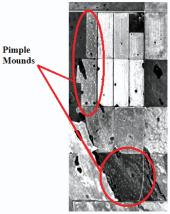
“Prairie pimples” or “pimple mounds” are micro-topographic features found on the flat to gently undulating floors of some glacial spillways, meltwater channels, and floodplains in southern Saskatchewan. In uncultivated or partially uncultivated areas, intact mounds are generally quasi-circular in shape, less than 0.5 metres high and between 10 and 20 metres in diameter. Most mound soils are disturbed by rodents, especially near their centre, and composed mainly of sandy silt or silty clay mixed with an abundance of pebbles and cobbles. In cultivated areas most mounds have been leveled off for agricultural purposes, but they can be seen on aerial photographs as light-coloured patches against the surrounding darker soils. In some areas, these patches are so abundant that the fairly regular pattern seen on aerial photographs is referred to as an “outbreak of prairie pimples.” Similar mound features across North America are known as pimple mounds, freckled land, earth mounds, or mima-like mounds. Although their origin has been debated by scientists for over a century, the process that formed these mounds still remains a mystery. Some popular theories include groundwater discharge, seismic activity, permafrost processes, and bioturbation by burrowing animals such as the pocket gopher.
L. Lee-Ann Irvine